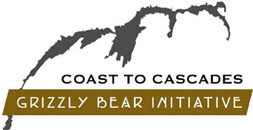2016 has been a busy year for the Coast to Cascades Grizzly Bear Initiative. It saw several public events to discuss grizzly conservation strategies, an increase in our outreach and public education efforts and a strengthening of our relationship with local First Nations. We have been very heartened to see the broad support for grizzly bear recovery across Southwest BC. Next comes the question of how to turn this support into action.
Coast to Cascades’ focus is to restore ecological conditions that facilitate the conservation and recovery of grizzly bears regionally including building support for habitat protections and conflict avoidance. A crucial first step is educating the public about how to share the land with grizzly bears safely and respectfully. This year we worked with our community partners on a number of events and workshop on reducing human-bear conflict. We also hosted and participated in a number of discussions with First Nations, the provincial government and scientists to share ideas and identify conservation priorities.
Here are some of our highlights from 2016 :
1. Human/Grizzly Bear Conflict Prevention
a. Hired Jolene Patrick, N’Quatqua Nation member to coordinate and conduct conflict prevention and grizzly ecology outreach to several St’át’imc First Nation communities. To date Jolene has met with several community members and held 2 grizzly bear focused workshops in those communities.
b. C2C Rancher Outreach Coordinator, Allen McEwan has made 3 trips to the Big Creek area of the South Chilcotin to speak with livestock producers about grizzly bear friendly range practices and gather information about potential cow/bear interactions that may lead to conflict. Allen’s mission is to work with ranchers to better understand grizzly bear movement and eventually work toward conflict preventive range strategies and practices.
c. Designed and posted “You are in Grizzly Bear Country” signs on several roads and trails in the C2C project area designed to raise public awareness and caution against illegal killing of protected grizzlies.
d. Maintain standing contributions to grizzly anti-poaching reward fund.
2. Public Outreach and Education
a. Tabled at farmers’ markets and other public events in Sea-to- Sky communities to educate people about local grizzly populations, threats to their existence , the need for community involvementand C2C programs .
b. Produced grizzly bear educational materials for distribution through public events, trailheads and other venues.
c. C2C team has been featured or quoted in several grizzly related media stories in Sea-to-Sky media outlets.
d. Hosted a symposium of First Nations leaders, scientists, conservationists and government officials to discuss strategies for grizzly bear conservation in Southwest BC.
3. Conservation Planning and Science
a. C2C team assembled Southwest BC’s research scientists to discuss and prioritize conservation actions to conserve and recover the region’s threatened grizzly bears.
4. First Nations and Government relations
a. C2C staff have met and presented to several area First Nations and local government councils on the regional grizzly bear situation and C2C activities.
b. C2C staff participated in a regional First Nations meeting of staff, councilors and elders to listen, present and discuss Traditional Ecological Knowledge, conservation needs and cultural and ecological significance of grizzly bears. The meeting was initiated by Okanagan Nation Alliance.
c. Received letters of support from the 3 First Nations (Squamish Nation, Okanagan Nation Alliance & St’át’imc Chiefs Council) whose territory C2C’s work covers. The statements affirmed the cultural importance of grizzly bears to their communities and their ongoing support of recovery efforts.
In 2017 we hope to build on these initiatives by expanding our public education efforts in communities across Southwest BC. We will also be working with our partners to develop a grizzly bear recovery plan for the region. Our hope is to see the provincial government adopt and implement this plan.
As for the bears themselves, things are looking pretty mixed. Around Whistler we’ve seen a re-bound in grizzlybear numbers. In other places like the North Cascades, the situation is not so promising. The next few years are going to be crucial if we want to ensure grizzly bears have a home in Southwest BC for generations to come. We need to safeguard grizzly bear habitat if we are to help threatened populations recover and reduce conflict with humans in areas where bears are increasing. A lot more work needs to be done but the levels of support we’ve see this year for grizzly bear recovery is encouraging. Let’s continue to work together these next 12 months to protect them!
To learn more about upcoming Coast to Cascades' public education initiatives and events, sign up for our email list.

